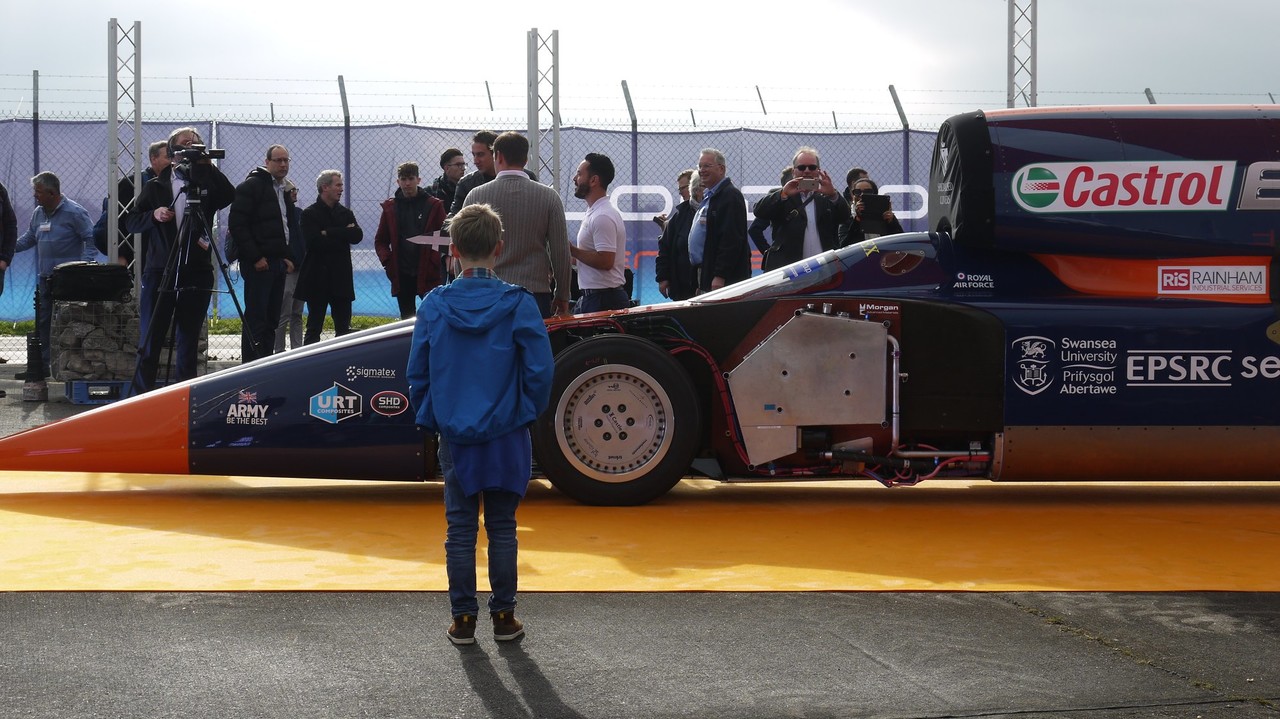
A supersonic engineering adventure
‘I got a funny feeling in my tummy’ said my son as Wing Commander Andy Green lit up the Rolls Royce Eurofighter engine at the first public test run of the Bloodhound Supersonic Car.
Bloodhound’s primary purpose is to inspire the next generation of STEM students but it wasn’t just my 7 year old who came home inspired after our trip to Newquay.
Bloodhound is the latest British attempt at the land speed record. With courtesy of Scottish sponsors Merlin ERD, we were lucky enough to join sponsors and the media at its first test on a Cornish airstrip.
With 20yrs experience in creative engineering and innovation, I'm starting to feel a bit like an old hand and it's great how a project like Bloodhound brings sharply back into focus two key values from my design engineering education.
Q: How do you design a 1000mph car?
A: Slowly and with great care.
We were lucky enough to spend some time with the person I most wanted to see, 85yr old aeronautical engineer Ron Ayers. The mastermind behind the shape of the car.
When Ron was my son’s age, he remembers looking up in awe as squadrons of Spitfires flew overhead during the Battle of Britain. ‘As a boy the noise of 12 Roll Royce Merlin engines has a profound effect on you’ said Ron. He feels this was the reason he wanted to study engineering.
I think it’s fair to say that my son’s ‘funny feeling’ as the afterburners fired up is as close as we can get to the modern day equivalent of Ron’s experience!
Why did the Bloodhound team choose a designer who was in his prime in the 1970s before computational fluid dynamics really existed?
For the simple reason that when you are pushing the boundaries with something that has never been done before, you want someone who has been working in innovation all their life.
Talking to Ron it became clear he has deep-rooted experience in the systematic process of designing in the ‘uncomfortable zone’ where first intuition, then careful iterative thought are required to conceive the fundamentals of the design. Powerful maths and computing then take over to test how it performs and identify incremental improvements.
‘It’s no use having a head full of numbers if you can’t communicate your ideas to your team’ was Ron’s advice for my son. Take a keen interest in Maths and English if one day you want to go on design engineering adventures with planes, rockets and supersonic cars.
My son woke me at 6am the morning after the test run, 'I can't sleep' ... he said. 'Here's a pen and paper, give me a lie in...'
Q. How do you design the cockpit for a car that covers a mile every 3.6sec?
A. Plywood, blue foam, masking tape and a little bit of Blu Tack.
This photo wasn’t very popular but it made me smile. It seems insignificant in comparison to the beautiful images and displays of the jet engine, carbon fibre monocoque and titanium 3D printed components. But this image goes to the heart of my experience of good design engineering for people.
This is rapid prototyping.
In this image, I can hear Andy Green saying, ‘I need to move my head significantly to see the speedo’…. Designer re-positions 10mm to the left, does that feel better? This is how to rapid prototype in the real world: low-cost sketch modelling solutions and quick iterations with the user.
The image below is the final layout.
Watching the Bloodhound test both inspired my 7-year-old and reinvigorated my own enthusiasm for my chosen profession of design engineering. This wondrous machine was created by an 85yr old human mind, not an Intel supercomputer. Furthermore, when a machine user interaction is required, the best and fastest method of development is traditional low fidelity sketch modelmaking, iterative refinement and evolution with the user.
The team may be reliant on sensors and computers to propel the car beyond the sound barrier, but for now, the creativity and determination of the human brain are still firmly in the driving seat!
Below is a short video, created by my son, in which Andy Green (the fastest man to travel on the surface of the earth) was kind enough to send a reply....
Want to learn more:-
- How do 4c reduce the risk of Innovation?
- http://www.bloodhoundssc.com/
- Andy Green Interviews Ron Ayers in Bang Goes the Theory
- Merlin ERD are extended reach drilling experts based in Perth Scotland
- Castle Precision the Scottish machining experts who made Bloodhounds wheels





CEng MEng MIMechE Onshore Wind Mechanical Engineer at SSE Renewables
6yGreat read Robin Smith! It's been a while since I've attended a Bloodhound event, so I'm pleased to see that things are progressing well. I too enjoyed the cockpit mockup photo. Is it just me or does the final layout have screens in a funny asymmetric configuration?
Senior Membership Development Manager, UK at Institution of Mechanical Engineers
6yFantastic, what a lovely piece Robin!
Director at Deri Jones & Associates Ltd
6ySaw the signpost as I was passing Newquay airport and still kicking myself I didn't know it was on and made time to see it.
Regenerative Leader/Facilitator/Designer
6yIndeed I can't see Ron Ayers mind and communication manner being replicated by an AI robot. So cool to see Struan with him and to hear of your re-inspiration!
Energy Manager at Edrington
6yBrilliant write up Robin. So true about working slowly and carefully to get it right. User feedback is the key but often last step taken before delivering a project. Bob Gray David Toy Douglas Toy Dave Hunter James Dodds